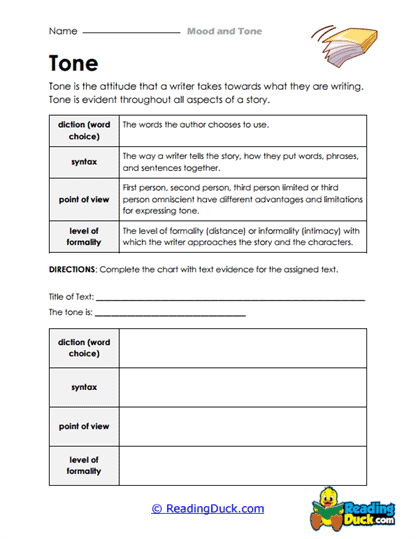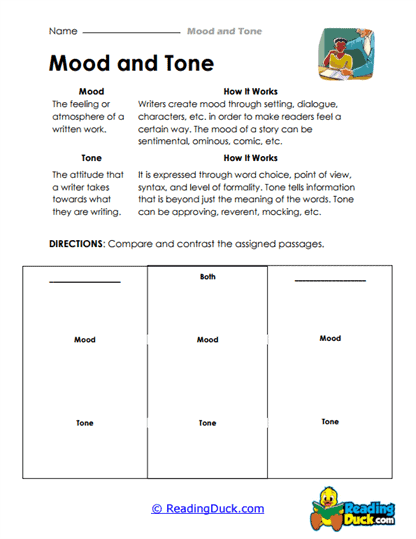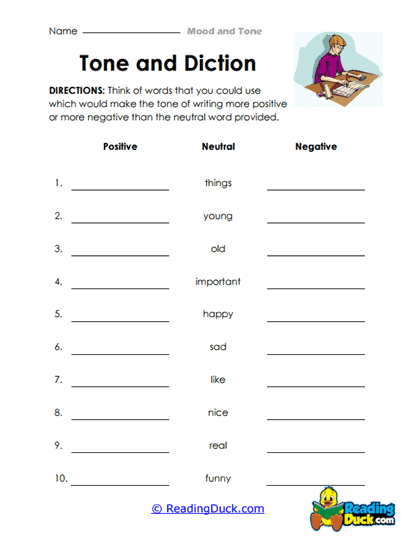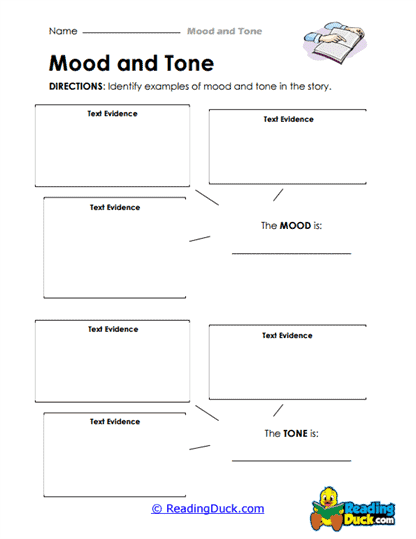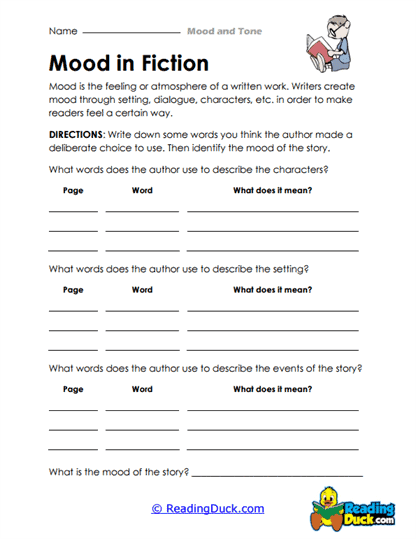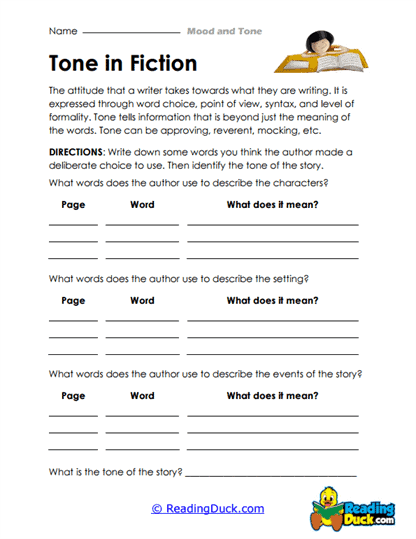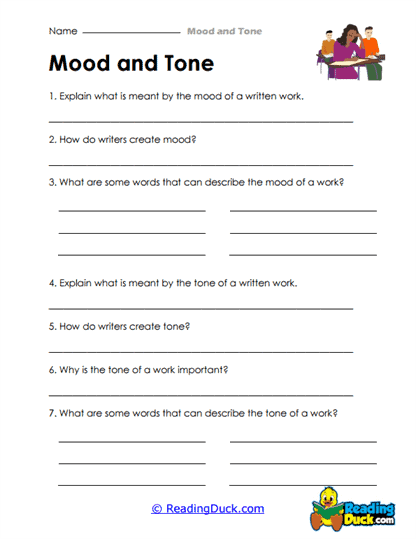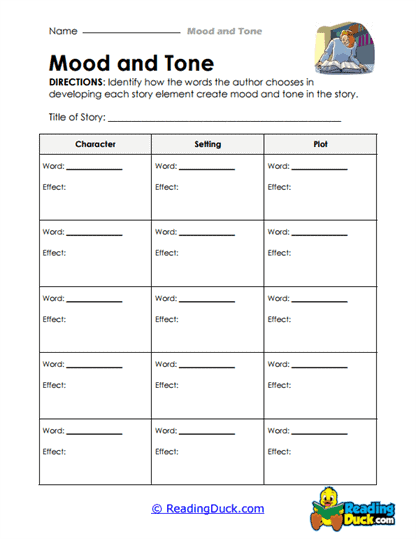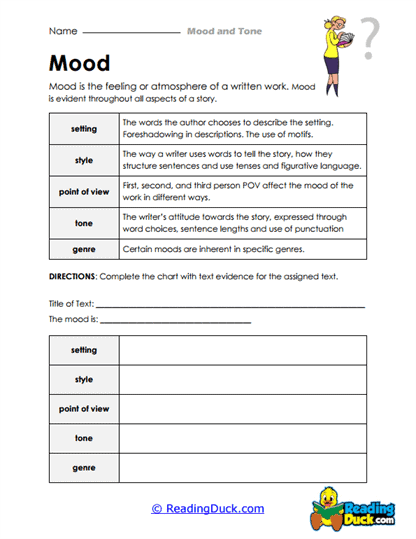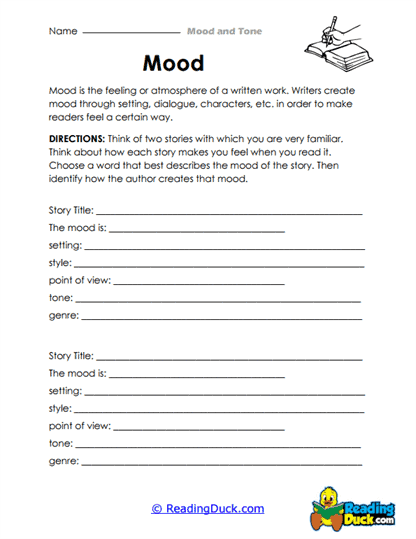Mood and Tone Worksheets
About Our Mood and Tone Worksheets
Our Mood and Tone Worksheets are carefully designed to help learners develop a solid understanding of two essential writing concepts: mood and tone. These worksheets serve as a valuable resource for educators, parents, and students, offering structured activities that guide learners through the process of identifying, analyzing, and applying mood and tone in writing.
Key features of our Mood and Tone Worksheets include:
- PDF format for easy viewing, downloading, and printing.
- Answer keys included with each worksheet to help assess student understanding.
- Versatile usage for classroom activities, homeschooling, or independent study.
- Applicable to different skill levels, from beginners to advanced learners.
These worksheets help students not only recognize mood and tone in texts but also apply these concepts to their own writing, improving both their reading comprehension and creative writing skills.
Understanding Mood and Tone: Step-by-Step Explanation
Mood and tone are often confused, but they represent two distinct elements of writing that greatly influence how a reader experiences a text. Understanding the difference between these two concepts is essential for students to fully grasp how writers convey meaning and evoke emotion in their works. Below is a clear breakdown of each concept:
Mood: The emotional atmosphere a writer creates for the reader. This refers to how the reader feels while reading a text and can be influenced by a variety of elements.
- Purpose: To evoke specific emotions or feelings in the reader.
- Created through:
Setting and imagery.
Descriptive details (adjectives, verbs, and adverbs).
Use of sensory language (touch, sound, sight, taste, and smell).
- Examples:
A peaceful mood can be established by describing a calm, sunny beach scene.
A tense mood may arise from a description of a dark, stormy night where shadows loom ominously.
Tone: The author’s attitude toward the subject or audience. Tone reflects how the author feels about the topic they are writing about, and it can vary widely depending on the writer’s purpose and audience.
- Purpose: To express the writer's feelings or viewpoint.
- Influenced by:
Word choice (formal vs. informal language).
Sentence structure (simple vs. complex).
Perspective (first-person, second-person, third-person).
- Examples:
A formal tone might be used in a scholarly article to maintain a professional attitude.
A sarcastic tone might appear in a comedic editorial to convey humor.
To help students distinguish between mood and tone, teachers can present excerpts from well-known works of literature. By asking students to identify how the text makes them feel (mood) and what they think the author’s attitude is (tone), students can start to see the differences more clearly. For example, in a horror story, the mood might be frightening, but the tone could be serious or suspenseful, depending on the language and style used by the author.
In-Depth Exploration of Mood and Tone in Writing
Mood and tone are not just tools for analyzing other writers' works—they are essential components of students’ own writing as well. By mastering these concepts, students can make intentional choices that shape their readers’ experiences. Understanding how to create a specific mood in a story allows students to control the emotional impact of their writing, whether they want to inspire excitement, sadness, or fear. Similarly, choosing the right tone ensures that their message is conveyed effectively to the intended audience.
For example, a student writing a persuasive essay on environmental issues may adopt a passionate and urgent tone to communicate the seriousness of the topic. On the other hand, if they are crafting a lighthearted story for a younger audience, a playful and humorous tone may be more appropriate. Through practice and guided analysis, students can learn to manipulate mood and tone in their writing to suit different purposes and audiences, ultimately becoming more confident and versatile writers.
Differentiated Instruction for All Learning Levels
Our Mood and Tone Worksheets are designed to cater to a wide range of student abilities and learning styles. These worksheets provide differentiated instruction, allowing teachers to adjust their use based on student needs.
For beginners:
-
- Focus on simple texts with clear moods and tones.
- Activities may include identifying mood and tone in familiar, easy-to-understand passages.
For intermediate learners:
-
- More complex texts that require deeper analysis.
- Exercises that involve comparing moods or tones across different texts.
For advanced students:
-
- Challenging passages that feature shifts in mood and tone.
- Opportunities to explore nuanced interpretations of an author’s attitude and the emotional impact of writing.
These worksheets can be used for students who are visual, auditory, or kinesthetic learners by incorporating different approaches to reinforce the concepts.
Classroom Use, Homework, and Flexibility
Our Mood and Tone Worksheets are designed with flexibility in mind, making them suitable for various instructional settings. Here are some ways these worksheets can be incorporated into daily lessons and learning environments:
Classroom Use:
-
- Teachers can use these worksheets to introduce mood and tone as part of their writing or literature units.
- Group activities where students collaborate to identify mood and tone in a shared text.
- Guided practice sessions where teachers walk students through the worksheets to demonstrate concepts.
Homework Assignments:
-
- Worksheets can be used as reinforcement activities, allowing students to practice identifying mood and tone on their own.
- Homework assignments that require students to analyze a text’s mood and tone using the worksheet’s structured format.
Long-Term Projects:
-
- These worksheets can form the foundation for larger writing assignments or creative projects.
- Used as part of a broader unit on narrative writing, essay composition, or literary analysis.
Building Critical Thinking and Creativity
Our Mood and Tone Worksheets encourage not only identification but also application of these concepts, fostering critical thinking and creativity. Students are often asked to engage with texts in deeper, more meaningful ways, making connections between mood, tone, and other literary elements.
These worksheets may include:
Textual Analysis:
-
- Passages where students identify and explain mood and tone.
- Comparison tasks where students contrast mood and tone in different texts.
Creative Writing Prompts:
-
- Opportunities for students to create their own writing, focusing on establishing a specific mood or tone.
- Prompts that challenge students to rewrite existing passages with a different mood or tone.
These activities encourage students to think critically about how authors use language to create atmosphere and convey attitude, while also applying those same techniques in their own writing.
Scaffolding for Progressive Skill Development
Our worksheets are designed with a scaffolded approach, gradually increasing in complexity as students build their understanding of mood and tone. This structure ensures that students can start with the basics and progress to more advanced tasks, reinforcing their skills as they go.
The scaffolding process includes:
Basic Level:
-
- Simple identification of mood and tone in short, straightforward texts.
- Guided questions that help students focus on key elements, such as word choice and setting.
Intermediate Level:
-
- Activities that require analysis of mood and tone in longer, more detailed passages.
- Worksheets that include multiple-choice questions alongside open-ended responses to allow deeper exploration.
Advanced Level:
-
- Students are asked to explore complex texts with multiple moods or tones.
- Writing assignments that challenge students to create their own pieces with specific moods or tones in mind.
Versatile and Practical Tools for Long-Term Learning
Our Mood and Tone Worksheets can be incorporated into various writing units and long-term projects. Their structure and progression make them suitable for different contexts, from daily lessons to extended assignments. The worksheets provide a comprehensive foundation for understanding how mood and tone influence a reader’s interpretation and how these elements can be used effectively in writing.
Benefits of long-term integration include:
- Reinforcement of key concepts: Using these worksheets over time helps solidify student understanding.
- Development of writing skills: As students advance, they can apply their knowledge to longer and more complex writing assignments.
- Adaptability for different writing units: These worksheets can be easily integrated into narrative writing, poetry, essays, and even persuasive writing units.
Our Mood and Tone Worksheets offer a versatile, engaging, and scaffolded approach to teaching two essential components of writing. Whether used for classroom instruction, homework, or as part of a long-term writing project, these worksheets provide learners with the tools they need to identify, analyze, and apply mood and tone effectively. With their focus on differentiation, critical thinking, and creative application, these worksheets are a valuable resource for educators, parents, and students alike.
